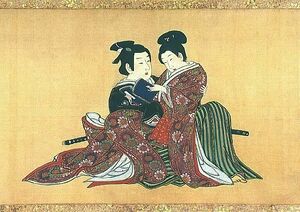Shudo
- Other Names: 男色 (nanshoku)
- Japanese: 衆道 (shudou, or shuudou), 若衆道 (wakashudou, or wakashuudou)
Shudô was a samurai custom in which adult samurai engaged in pederastic relationships with younger samurai. This custom is most prominently seen, or discussed, in the Sengoku and Edo periods.
The older man in the relationship, known as the nenja (念者), and the younger man, known by a variety of terms including wakashû (若衆), formed a close, tight personal relationship with one another. A nenja typically engaged in such relationships with only one wakashû at a time, and vice versa. Though much discussion today, based in modern/Western social mores about homosexual relationships, focus strongly on the homosexual sexual acts involved in the relationship, shudô relationships went beyond this, and were strong personal and sentimental or emotional relationships, which involved as well strong elements of mentorship. Mentorship and training in the "warrior" lifestyle and values of the samurai was a major element of the relationship.
From the medieval period, if not earlier, the Japanese considered homosexual acts and relationships as simply a matter of taste or preference, and as something which simply varied from person to person, and over time. While Confucian teachings place a strong emphasis on family, and on proper relationships with one's parents, spouse, and children, there was no parallel in Japanese tradition to the biblical bans on such activities. The specific mode of shûdô male-male relationships, particular to the samurai class, emerged in the medieval period, and by the Edo period was likely seen as a firmly entrenched traditional custom.[1]
Particularly popular among kabukimono and other individuals on the peripheries of the class system, shûdô is said to have raised anxieties among Tokugawa authorities at the beginning of the Edo period, as individuals often obeyed stronger loyalties to their romantic/sexual partners than to the normal feudal structure. An incident in 1612 is an example of precisely the sort of thing the shogunate was worried about: a kabukimono who served a samurai lord as a lowly servant killed that lord, as revenge for the lord's execution of another kabukimono - a close friend, perhaps a lover - sometime previously.[2]
References
- Maki Morinaga, "The Gender of Onnagata as the Imitating Imitated," positions 10:2 (2002), 245-284.
- ↑ Eiko Ikegami, Bonds of Civility, Cambridge University Press (2005), 269-270.
- ↑ Ikegami, 263.
See Also
- Chigo - young boys within the Buddhist tradition, who sometimes had a similar sort of relationship with adult Buddhist monks
